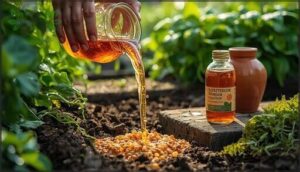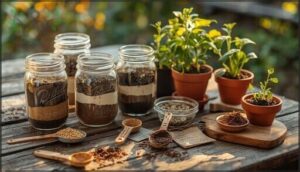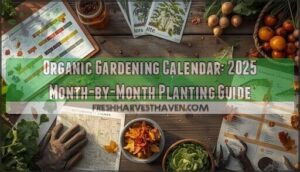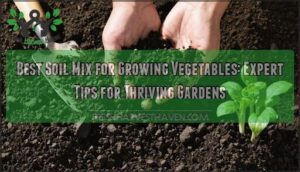This site is supported by our readers. We may earn a commission, at no cost to you, if you purchase through links.
Your kitchen waste holds more potential than you might realize. Those banana peels, coffee grounds, and vegetable scraps you toss in the trash contain the same nutrients that plants need to thrive—nitrogen for lush leaves, phosphorus for strong roots, and potassium for disease resistance.
Instead of buying synthetic fertilizers that can harm soil microbes and leach into groundwater, you can create effective alternatives from materials already in your home and yard. Organic fertilizer recipes work with nature’s cycles, feeding both your plants and the living soil beneath them.
The techniques range from simple overnight soaks to more involved composting methods, each suited to different garden situations and time constraints.
Table Of Contents
- Key Takeaways
- Essential Nutrients in Organic Fertilizers
- Homemade Liquid Fertilizer Recipes
- Solid Organic Fertilizer Methods
- Natural Soil Amendments and Enhancers
- Customizing Fertilizer Recipes for Your Garden
- Frequently Asked Questions (FAQs)
- What is the best homemade organic fertilizer?
- What is the 20/20-20 rule for fertilizer?
- What are the three main ingredients of organic fertilizer?
- What are the 3 main ingredients of organic fertilizer?
- How to make complete organic fertilizer?
- Can you use banana peels and eggshells as fertilizer?
- How do I make my own organic fertilizer?
- What is the formula for organic fertilizer?
- What is the best natural fertilizer for vegetable gardens?
- How long can homemade organic fertilizers be stored?
- Conclusion
Key Takeaways
- You can create effective organic fertilizers from kitchen waste like banana peels, coffee grounds, and eggshells, which provide nitrogen, phosphorus, and potassium without harming soil microbes or groundwater the way synthetic fertilizers do.
- Liquid fertilizers such as comfrey tea, nettle tea, and banana peel water work faster than solid amendments because nutrients are already dissolved, making them ideal for quick feeding during peak growing season when diluted properly.
- Solid methods like composting, vermicomposting, and Bokashi fermentation build long-term soil fertility by slowly releasing nutrients over months, with each technique suited to different time constraints and waste types.
- Customizing fertilizer blends based on soil testing delivers 17% better nutrient uptake than generic mixes, since different crops need different ratios—leafy greens thrive on nitrogen while fruiting plants need more potassium.
Essential Nutrients in Organic Fertilizers
Your garden plants need more than just water and sunlight to thrive. Understanding which nutrients they require—and where to find them naturally—helps you create fertilizers that actually work.
Let’s look at the essential elements your soil should provide, the organic materials that supply them, and how different crops benefit from each one.
Key Macro- and Micronutrients for Plants
Your plants need a balanced diet to thrive. The big three macronutrients—nitrogen, phosphorus, and potassium—fuel growth, flowering, and fruit production. Without nitrogen, corn yields drop 40%. Plants also rely on micronutrients like iron, zinc, and boron:
- Iron prevents leaf yellowing
- Zinc fights stunted growth
- Boron ensures flowers and fruit set properly
- Magnesium powers photosynthesis
Micronutrient deficiency can slash yields by half. Understanding the corn root system is essential for maximizing crop yields.
Which Plants and Materials Supply Each Nutrient
You can gather organic plant fertilizer ingredients from your own backyard. Nitrogen sources include grass clippings (4:2:1 NPK ratio) and alfalfa, which fixes 250–500 lb per acre. Phosphorus materials like bone meal supply 12–16% P2O5, while potassium suppliers such as wood ash deliver 5–7% potassium. Calcium providers include crushed eggshells at 95% calcium carbonate.
Seaweed offers trace nutrients—iodine, boron, zinc, and manganese—for complete plant nutrition. For ideal plant growth, understanding natural nitrogen sources is essential.
Benefits for Different Types of Crops
Now that you know where nutrients come from, let’s see how they boost your harvests. Organic fertilizers deliver real improvements across crop types by supporting soil health and sustainable agriculture:
- Vegetables: Improved water retention and slow phosphorus release boost nutrient cycling for better yields
- Fruits: Higher sugar content (up to 8.65 °Brix) and increased antioxidants
- Grains: 15% organic substitution increases iron and zinc without reducing crop yield boost
- Root crops: Enhanced soil aeration promotes stronger tuber formation
Homemade Liquid Fertilizer Recipes
Liquid fertilizers are one of the easiest ways to feed your plants quickly and effectively. You can make them from materials you already have in your kitchen or garden, and they work faster than solid amendments because nutrients are already dissolved in water.
Here are four proven recipes that will help you build a stronger, more productive garden.
Comfrey Tea Preparation and Uses
Comfrey tea stands out as a powerhouse organic plant fertilizer, delivering potassium-rich nutrition that fruiting crops love.
You’ll steep fresh comfrey leaves in water for 8–12 weeks until they break down into a dark, concentrated liquid.
Dilute it 1:5 or 1:10 before applying as a foliar feed or soil drench every two weeks during peak growing season—your tomatoes and peppers will thank you.
Stinging Nettle and Weed Tea Methods
Stinging nettle packs nitrogen, magnesium, and iron into every leaf—perfect for boosting seedlings and young transplants.
Chop fresh nettles, steep them in water for 2–3 weeks until fermented, then strain. Dilute 1:10 before applying every 3–4 weeks to avoid burn.
You can toss in chard, kale, or other weed trimmings to diversify nutrients and create custom liquid compost blends.
Banana Peel, Rice Water, and Vegetable Water Fertilizer
Your kitchen sink holds hidden treasure—banana peels, rice water, and vegetable water all make outstanding liquid fertilizers. Banana peel water delivers up to 148 mg/g of potassium for vigorous fruit set and flowering. Rice water provides 29,525 ppm magnesium, boosting root strength by 22%.
Soak peels 2–3 days, dilute 1:5, and apply biweekly to feed soil microbes and balance nutrients naturally.
Enhancing Liquid Fertilizers for Maximum Effect
Microbial enhancers and biofertilizer blends release nutrient synergy in your comfrey tea, liquid seaweed, and compost tea recipes. Adding fish emulsion or kelp extract accelerates mineralization by 15–22%, while foliar feeding methods boost micronutrient absorption by 35%.
Precision application through soil testing and proper dilution prevents damage—over-concentration reduces seedling survival by 30%.
Blend multiple organic sources to deliver trace elements that improve crop resilience through liquid fertilizer optimization.
Solid Organic Fertilizer Methods
Solid organic fertilizers give your soil a slow, steady release of nutrients that builds fertility over time. Unlike liquid feeds that work fast and fade, these methods transform kitchen waste and plant materials into long-lasting soil conditioners.
Here are three reliable approaches you can start using right away.
Traditional Composting Step-by-Step
Building a compost pile is like assembling layers of a cake—alternating greens and browns in 6–8-inch sections, keeping the carbon-to-nitrogen ratio around 30:1.
Monitor your pile’s temperature regularly, aiming for 130–150°F during the active phase. Turn your compost every few weeks to boost aeration and speed decomposition.
Maturity indicators include stable temperature, crumbly texture, and an earthy smell after several months.
Vermicomposting and Bokashi Techniques
If you’re ready to work faster than traditional composting, vermicomposting and Bokashi fermentation offer powerful alternatives. Vermicomposting harnesses worm castings to enrich soil microbes, generally finishing in 2–4 months. Bokashi fermentation processes organic waste in just 2–4 weeks through anaerobic breakdown.
- Vermicomposting increases nutrient bioavailability, especially nitrogen and phosphorus
- Bokashi retains more carbon compounds, reducing volatilization losses
- Worm composting produces compost tea when moisture drains through bins
- Bokashi excels at managing high-moisture materials like vegetable scraps
- Both composting techniques support diverse soil microbes for healthier gardens
Using Kitchen Scraps and Plant-Based Materials
Your everyday scraps—vegetable peels, coffee grounds, fruit rinds—turn into nutrient-rich compost faster than you might expect. Kitchen waste combined with yard clippings reaches maturity in 8–12 weeks when turned regularly.
You can boost nitrogen levels by layering in comfrey or nettles. Once finished, this homemade fertilizer provides up to 21% of your garden’s NPK needs while diverting household waste from landfills.
Natural Soil Amendments and Enhancers
Not every organic fertilizer needs to be liquid or fully decomposed. Sometimes your soil just needs a targeted boost of specific nutrients or a structural improvement that helps plants thrive.
The amendments below work directly in the ground, releasing their benefits over time as they break down naturally.
Application of Bone Meal, Blood Meal, and Fish Meal
Among single-ingredient fertilizers, bone meal, blood meal, and fish meal stand out for their targeted nutrient profiles.
Blood meal delivers 12–15% nitrogen at application rates of 10–20 lbs per 100 square feet, boosting crop yields up to 25% when soil pH stays between 6.0–7.0. Bone meal supplies 15% phosphorus for roots and flowers, while fish meal adds trace elements and minimizes nutrient loss through controlled release.
Using Greensand, Wood Ash, and Biochar
Greensand, wood ash, and biochar bring unique strengths to soil conditioning. Greensand provides up to 8% potassium and improves water retention, while wood ash delivers 10–35% calcium and counteracts acidity. Biochar excels at carbon sequestration, raising soil organic matter by nearly 5% and boosting pH by up to 4 units.
These organic fertilizer amendments transform fertility enhancement through sustainable gardening practices that last for years.
Crushed Eggshells and Oyster Shells for Calcium
You’ll find calcium in two kitchen staples: crushed eggshells and oyster shells. Eggshells offer fast-acting calcium with 39% bioavailability, preventing blossom end rot in tomatoes. Oyster shells release nutrients slowly while balancing soil pH and adding trace minerals like magnesium.
Grind eggshells finely for quick results, or save eggshell water from boiling. Both boost soil health and turn waste into homemade fertilizer ingredients.
Customizing Fertilizer Recipes for Your Garden
Now that you know your options for amendments and natural boosters, you can start tailoring fertilizer recipes to match what your garden actually needs.
Different plants call for different nutrient ratios, and measuring ingredients carefully helps you avoid overfeeding or nutrient imbalances.
Let’s walk through how to create custom blends, mix them safely, and store your homemade fertilizers the right way.
Creating Blends for Specific Plant Needs
Your garden isn’t a one-size-fits-all situation, so your homemade fertilizer shouldn’t be either. Soil testing reveals what your plants actually need, making custom blending far more effective than guessing.
Soil testing reveals what your plants actually need, making custom fertilizer blends far more effective than guessing
Leafy greens thrive with nitrogen-rich plant nutrient sources like blood meal, while tomatoes need potassium from banana ash for better fruit set.
Targeted fertilizer recipes boost nutrient uptake by 17% compared to generic mixes, improving fertilizer optimization and overall plant nutrition.
Measuring and Mixing Homemade Fertilizer Ingredients
Precision matters when choosing fertilizer ingredients and creating fertilizer mixes. Use a kitchen scale to weigh materials—standardized fertilizer ratios prevent measurement errors that cause plant damage.
For compost tea, dilute at 1:8 for week-old brews or 1:15 for older concentrates. When scaling recipes to larger beds, convert your proven batches to kilograms per 100 square meters.
These mixing techniques guarantee consistent nutrient profiles across every application.
Tips for Safe Storage and Application
Beyond mixing techniques, proper fertilizer handling protects both your garden and the environment. Store homemade fertilizer blends in sealed containers at 5°C to 30°C, away from sunlight and food. Label everything clearly for storage safety and contamination control.
Follow application rates carefully—overapplication harms soil health and fertilization goals. Keep records of what you apply, when, and where, so you can track environmental impact and adjust future homemade fertilizer blends.
Frequently Asked Questions (FAQs)
What is the best homemade organic fertilizer?
Like finding the perfect tool in your shed, the best homemade fertilizer blends match your plants’ needs.
Compost tea offers balanced nutrients, while tailored organic fertilizers using kitchen waste deliver targeted soil health improvements for various garden crops.
What is the 20/20-20 rule for fertilizer?
The 20-20-20 rule refers to a balanced fertilizer mix with equal NPK ratio: 20% nitrogen, 20% phosphorus, and 20% potassium by weight, delivering uniform plant nutrients for healthy growth across diverse crops.
What are the three main ingredients of organic fertilizer?
The three main ingredients in organic fertilizers are nitrogen, phosphorus, and potassium—often called N-P-K.
Together, these soil nutrients account for over 90% of primary macronutrients by weight in most organic matter formulations.
What are the 3 main ingredients of organic fertilizer?
Your homemade organic fertilizer lives or dies by nitrogen, phosphorus, and potassium—the three essential nutrients every thriving plant demands.
You’ll find nitrogen in manure and compost, phosphorus in bone meal, and potassium in wood ash.
How to make complete organic fertilizer?
Complete organic fertilizer requires balancing nitrogen, phosphorus, and potassium. Blend blood meal for nitrogen, bone meal for phosphorus, and greensand for potassium.
Adjust ratios based on your specific crop needs for ideal nutrient content.
Can you use banana peels and eggshells as fertilizer?
Yes, you can turn banana peels and eggshells into effective fertilizer. Banana peel benefits include potassium for strong growth, while eggshell fertilizer provides calcium to strengthen plant cells—both support sustainable gardening practices.
How do I make my own organic fertilizer?
You can make organic fertilizer by mixing kitchen waste with water to create compost tea, or by layering nitrogen-rich materials like grass clippings with carbon sources such as dried leaves in a compost bin.
What is the formula for organic fertilizer?
Organic fertilizers don’t follow a single formula. You’ll create nutrient balance by blending materials—like mixing four parts seed meal with lime for soil pH adjustment—targeting specific fertilizer ratios that match your crops’ needs.
What is the best natural fertilizer for vegetable gardens?
Compost stands out as the top choice for your vegetable garden, delivering balanced nutrients while boosting soil health and feeding beneficial soil microbes.
Compost tea and natural amendments like fish meal complement it beautifully.
How long can homemade organic fertilizers be stored?
Storage conditions make or break your homemade organic fertilizers. Diluted liquids last just 1–2 days before spoiling, while sealed concentrates remain viable indefinitely.
Finished compost stays effective up to 12 months if kept dry and covered properly.
Conclusion
Think of your garden as a living conversation between soil, plants, and the materials you provide. When you brew banana peel tea or turn last week’s scraps into compost, you’re speaking nature’s language.
These organic fertilizer recipes don’t just feed plants—they rebuild underground networks that make gardens resilient. Start with one method that fits your schedule, observe what thrives, and adjust as you learn what your soil truly needs.
- https://earth.org/organic-fertilizer-cultivating-greener-fields-and-healthier-crops/
- https://www.fortunebusinessinsights.com/north-america-organic-fertilizers-market-109411
- https://www.mordorintelligence.com/industry-reports/us-organic-fertilizers-market
- https://www.marketsandmarkets.com/Market-Reports/organic-fertilizer-Market-171744317.html
- https://www.futuremarketinsights.com/reports/demand-for-organic-fertilizer-in-north-america











